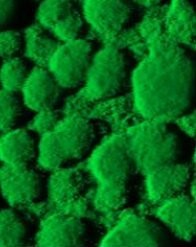$1.2m grant for biophysics research

The School's Dr Rosalind Allen is part of an international team of researchers that has been awarded $1.2m to study how bacterial cells self-assemble into 3-D spatially-organized structures. It will also investigate how the different structures influence cooperation within the assembly.
Intercellular cooperation is one of the most important functional behaviours of multicellular assemblies, but from an evolutionary perspective it is also one of the least understood. Experiments and computational modelling will be used to explore self-assembly in Pseudomonas aeruginosa, a common human pathogen that readily forms assembled structures called biofilms.
The team hopes to uncover some of the “design rules” of bacterial self-assembly by manipulating the initial cell configuration of their samples and then tracking how the biofilms form over time. The team will explore, for example, whether certain spatially-structured biofilms are more cooperative and more resistant to invasion by “cheats,” which are cells that reap the benefits of cooperation without paying the costs.
"I am very excited about this grant because it gives us a great opportunity to do really interesting international and multidisciplinary research, which could be relevant not just to how bacteria assemble but also to how biological cells build 3D structures in general." Dr Rosalind Allen, Institute for Condensed Matter and Complex Systems
The P. aeruginosa research will focus on gaining fundamental understanding of how cells assemble into 3D structures, rather than on specific applications. But it is hoped that knowledge of how to design cell assemblies will benefit biotechnology and medicine in the long-term. For example, it might be possible to design surgical implants that are resistant to colonisation by the bacteria that cause chronic infections.
The computational modelling will be carried out by the School's Institute for Condensed Matter and Complex Systems (ICMCS), where it will link with the Institute's ongoing investigation into microbial population dynamics. The work also links to an EPSRC-funded collaboration with Kevin Stratford of EPCC and Davide Marenduzzo of ICMCS, which is developing computational tools for rare event simulations.
The multidisciplinary team is led by Dr Vernita Gordon of the University of Texas at Austin (Physics) and also includes Dr Thomas Bjarnsholt (University of Copenhagen, Microbiology) and Dr Steve Diggle (University of Nottingham, Biomolecular Sciences).
The $1.2m Young Investigator grant was made by the Human Frontier Science Program (HFSP), an international NGO funded by the governments of the G7 nations. HFSP provides research grants to teams of scientists from different countries who wish to combine their expertise to approach questions that could not be answered by individual laboratories. Emphasis is placed on novel collaborations that bring together scientists from different disciplines to focus on problems in the life sciences.

